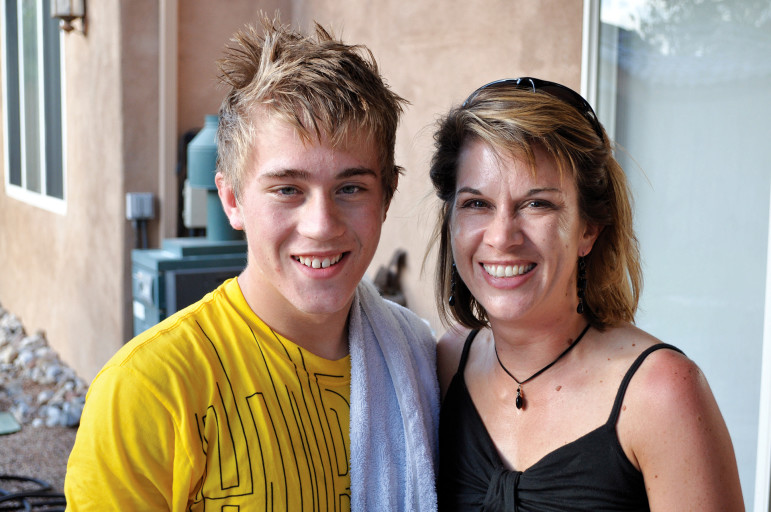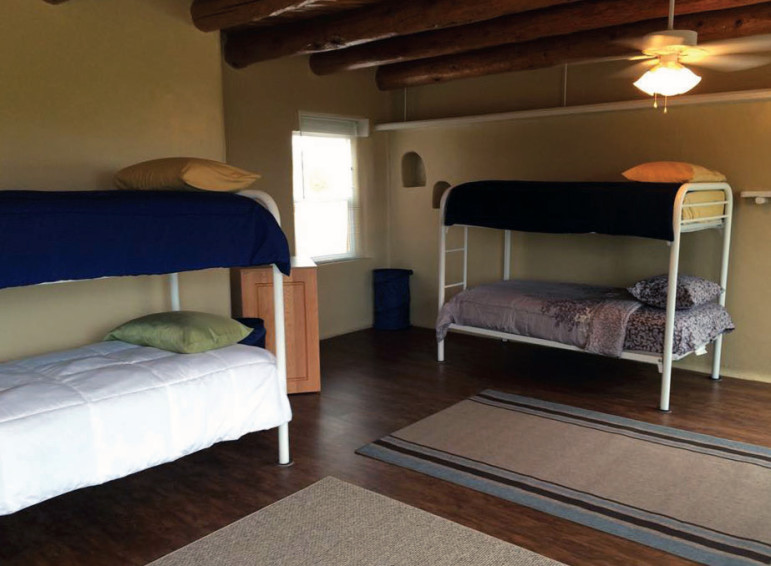Adolescents are particularly susceptible – and treatment must be long term
An unlikely group gathered last spring in Albuquerque, New Mexico, for the opening of a new addiction-treatment center just for teens. Probation officers and social workers stood with community leaders and government officials. Mayor Richard J. Berry gave a keynote address, launching Serenity Mesa Treatment Center.
“So many people wanted to speak, we could have been there all night,” said executive director and co-founder Jennifer Weiss-Burke. For her, the moment was bittersweet. She conceived the project after losing her 18-yearold son to a heroin overdose.
Serenity Mesa offers long-term residency of up to one year, with individualized treatment tailored for youth — exactly the resource Weiss-Burke couldn’t find when her son, Cameron, needed it. Addicted to prescription painkillers after a high-school sports injury, he moved on to heroin, which was cheaper and more easily accessible. His parents tried everything, more than once sending him out of state for treatment.
“It was never enough,” Weiss-Burke told a local TV reporter last year. “Thirty days here, 30 days there, maybe detox for five days. It was never long term, and that’s what he needed. Recovery from heroin addiction requires long-term treatment.”
During the course of two years, Cameron would seem to recover, only to relapse. In 2011, Weiss-Burke found him dead in his room.
According to a 2012 report from the National Institute on Drug Abuse: “Most addicted individuals need at least three months in treatment to significantly reduce or stop their drug use.”
Weiss-Burke turned her grief into action, co-founding the nonprofit Healing Addiction in Our Community and taking its cause — “Not Another Life Lost” — to the state capitol in Santa Fe. Her efforts as a citizen-lobbyist have resulted in passage of two pieces of legislation: One bill requires doctors to use a statewide prescription drug-monitoring program; the other requires all medical practitioners to complete a course in addiction and pain management when their licenses are renewed.

PHOTOS BY JENNIFER TORREZ
Weiss-Burke and husband David Burke at the ribbon-cutting ceremony for Serenity Mesa.
Early intervention
Incidents of addiction peak between ages 15 and 21, noted Dr. David E. Smith in a 2011 article for the American Medical Association Journal of Ethics. If left untreated, the damage multiplies. When brain development is disrupted by drug use during adolescence, adults later may not be able to respond appropriately to emotional, cognitive or social cues.
Although drug addiction is a long-acknowledged problem, addiction medicine has been neglected by the U.S. medical system, according to a 2012 study by the National Center on Addiction and Substance Abuse at Columbia University.
“While a wide range of evidence-based screening, intervention, treatment and disease management tools and practices exist, they are rarely employed,” the report found.
“Most medical professionals who should be providing treatment are not sufficiently trained to diagnose or treat addiction, and most of those providing addiction treatment are not equipped with the knowledge, skills or credentials to provide the full range of evidence-based services,” the report said.
“When substance use disorders occur in adolescence, they affect key developmental and social transitions, and they can interfere with normal brain maturation,” the National Institute on Drug Use reported in 2014. “These potentially lifelong consequences make addressing adolescent drug use an urgent matter.”
The first line of defense is primary health care. To increase the number of physicians trained to diagnose and treat addiction — and to recognize early signs of adolescent substance use disorder — Smith would like to see addiction medicine mandatory in medical school.
“Engaging people earlier in their addiction improves their chances of recovery and overall better health,” Smith said. “Meanwhile, costs for the health care system are dramatically reduced.”
A youth-centered approach
The new treatment center is good news for the state of New Mexico, where “the proportion of youth overdosing from heroin has increased more than fivefold since 2004,” according to the Opioid Needs Assessment commissioned by the City of Albuquerque in 2011.
In 2014, Weiss-Burke submitted a successful proposal to the state’s Health and Human Services Committee to help fund New Mexico’s first Adolescent Transitional Living and Recovery Center. The City of Albuquerque and Bernalillo County also pitched in, and nonprofit Serenity Mesa opened its doors May 15, 2015 — on the site of an abandoned residential treatment facility, which is being renovated one building at a time.
That month, a National Institutes of Health report affirmed that teens who inject or use heroin require “more structured attention and a higher level of monitoring during treatment.”
Nationwide, deaths from heroin overdose — in all age groups — doubled from 2010 to 2012, according to a 2014 study from the Centers for Disease Control and Prevention. In response, communities are seeking new strategies to treat addiction and speed access to care. And, after years of addiction treatments geared to adults, the unique needs of youth are being studied and addressed.
Serenity Mesa is one of the youthcentered programs that spring from these efforts. Such programs offer evidencebased treatment (EBT), that is, types of therapy that have shown measurable results. Among the many types of EBT are: Screening, Brief Intervention and Referral to Treatment (SBIRT), a preventative protocol for early detection; Motivational Interviewing, a counseling approach that guides individuals to set goals; and Functional Family Therapy (FFT), which treats teens in a family setting.
Addiction requires continuing care, no less than hypertension or diabetes. While public policy and social attitudes have begun to catch up with science, treatment for teens lags far behind. The 2012 National Survey on Drug Use and Health found that 90 percent of drug-addicted kids in the U.S. aged 12 to 17 get no treatment at all.
[Related: Unspoken Truths: Young People in Recovery]
Recent research shows that critical brain circuits are still developing during the teen years, according to the National Institute on Drug Abuse. Because rewards pathways mature long before executive functions — which include decision-making and self-control — adolescents are particularly susceptible to drug abuse and addiction.
Motivation-focused treatment
Dr. Holly Waldron has been studying adolescent behavior for 30 years as a clinician and researcher. Today she is a senior scientist at the Oregon Research Institute and director of the Center for Family and Adolescent Research, which runs drug-abuse treatment programs for youth in Oregon and in New Mexico. Waldron oversees clinical studies of new treatment approaches as well as training and supervision of therapists, and adapts treatments for use in a variety of cultural settings.
“Twenty years ago, we were just beginning to focus on evidence-based treatment for drug-involved youth,” Waldron said. “Historically, interventions for addictive behaviors have included confrontational approaches, but we’ve learned that confrontation does not produce effective change in substance-abuse behavior.
“We have developed motivation-focused interventions,” she said, “including functional family therapy and cognitive behavioral treatments for adolescent substance abuse.”
“We’re actively involved in taking these treatments to community settings,” she said. “If we can connect kids to treatment, we know they’ll improve.”
Most health insurers now require proof that addiction programs use evidence-based treatment, a sign of efficacy. And since the 2013 Affordable Care Act expanded the Mental Health Parity and Addiction Equity Act, more adolescents will have better access to insurance coverage.
Yet, teens rarely enter rehab voluntarily. “Clinicians are dependent on systems like juvenile justice and the schools to get teens connected to treatment,” Waldron said.
Making family therapy work
Some treatments for teens with substance use disorder engage the whole family. FFT is one approach Waldron favors, and has been studying in depth. In a dozen or more one-hour sessions, the program works to defuse negativity, then introduces skills training in family communication, parenting, problem solving and conflict management. Later sessions strengthen a family’s capacity to navigate community resources, which can prevent relapse.
Waldron wanted to know how ethnicity might affect FFT outcomes. In Albuquerque, one-half of the client population of the Center for Family and Adolescent Research is Hispanic. Among these are first- and second-generation Mexican Americans, plus many who identify as Hispanos — Spanish-speakers whose families are native to the area with roots going back more than 500 years.
“We have found consistently across all of our studies that Hispanic families have responded to Functional Family Therapy as well as or better than Anglo families,” she said.
It is clear that FFT works well in homebased and clinical settings. But New Mexico is vast, mostly rural and sparsely populated. What if the nearest clinic or mental health professional is 300 miles away? It’s a national concern: More than 15 million children live in rural America, according to a 2012 Housing Assistance Council report.
To see if technology can bridge the gap, a study is underway to compare results of family-based treatment delivered face-toface and via videoconference.
Privacy is another benefit of videoconferencing, Waldron noted. “If you live in a small town and your car is parked in the lot at the mental health clinic, everybody knows that’s your car. In Native American communities, if you go to a tribal counselor, it’s more likely people will know your business … But if you’re in your home and you’re talking to your therapist over the Internet, you may have greater confidentiality. That’s important to families.”
Videoconference dynamics can be complicated, however. “It’s harder to discern over a video stream how people are responding,” Waldron said. “If they’re quiet, if they’re becoming emotional, we might not see cues.”
To compensate, “the therapist has to do verbal check-ins with each member of the family,” Waldron explained. She posed an example, meant to invite participants to describe their feelings: “I hear you being quiet. Does this topic hit close to home for you all?”
So far, the results are good. The study ran through November, but Waldron said preliminary data shows the Skype-based treatment is as effective as treatment delivered face-to-face at home. If, as Waldron expects, the final data shows measurably improved outcomes (a decline in drug use, better family dynamics), and if results can be reproduced in other settings, videoconferencing may count as a treatment break-through.
“It will mean that it’s possible to get the best treatment to kids who would never have access otherwise,” she said.
Treating addiction with medicine
At HealthRIGHT 360, a California nonprofit created in 2011 when the Haight-Ashbury Clinic merged with the local residential center Walden House, treatment can include individual or group therapy, family therapy and mindfulness meditation. All can be used in combination with a biomedical therapy, such as methadone. While methadone can be effective in addiction recovery for adults, it is not wellsuited for teens, according to Dr. Ako Jacintho, HealthRIGHT 360’s medical director.
Methadone is highly regulated and can only be administered at methadone clinics. The drug must be taken daily, so trips to and from the clinic — often far from home and work — can be especially difficult for teens. And, Jacintho noted, teens may encounter other addicts at the clinic, as well as opportunities to buy drugs.
The maintenance drug often prescribed for teens is Suboxone, a combination of buprenorphine, an opiate substitute that eliminates craving, and naloxone, which blocks euphoric effects. Suboxone doesn’t cause drowsiness, and, the equilibrium it provides can make it easier to identify and treat co-occurring disorders like depression or anxiety. The dosage is eventually tapered.
A 2014 Yale School of Medicine study showed that ongoing maintenance treatment with Suboxone is more effective than detoxification and abstinence alone.
“There is strong data on Suboxone,” Jacintho said. When combined with behavioral therapy, Suboxone can reduce relapses and promote recovery. And, it can be prescribed and given by a trained and certified primary care physician — in a doctor’s office, rather than a clinic, Jacintho noted. “We get better outcomes when we change from methadone clinics to primary care.”
As education and training around addiction improve, Smith hopes more attention will be paid to the people he calls “role models of recovery.”
Vitka Eisen, CEO of HealthRIGHT 360, is one of them. She was a heroin addict from age 19 to 25, until the Haight Ashbury Free Clinic and Walden House put her back on her feet. Three college degrees later, including a doctorate in education from Harvard University, she’s proud to call herself “a 1987 Walden House graduate.”
Having been homeless during periods of her addiction, Eisen knows the difficulties teenage addicts may face.
“It’s hard for these kids to get off heroin, because they lead such challenging lives. If a kid’s using heroin, there’s a high likelihood of trauma exposure” from school, work or family life, she said.
“Drugs may seem like the best thing in their life, the thing that helped them deal with how they experience the circumstances of their lives.”
The most effective treatments for teens, she says, build on the individual’s strengths while empowering them to better handle stressful circumstances.
And, these treatments can gain in effectiveness when used in combination with medication, such as Suboxone.
Jacintho also says there soon will be greater acceptance of such so-called “integrated treatment” for teens. “The data is going to show positive health outcomes,” he predicted.
Smith is cautiously optimistic, too. “Every interface with a health-care professional should give a consistent message,” he said. “We care.”
More related articles:
Childhood Obesity Prevention Serves as Framework to Address Adolescent Substance Use
Talking to a Doctor about Substance Use
The Most Effective Prevention for Teen Substance Use Not Widely Deployed: Report
Engaging Kids Fights Substance Abuse, Organizations Say



































